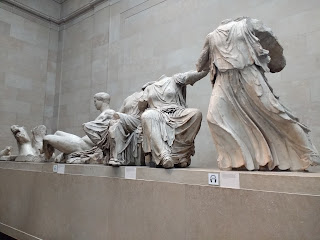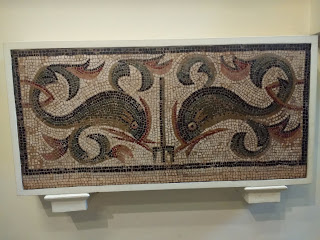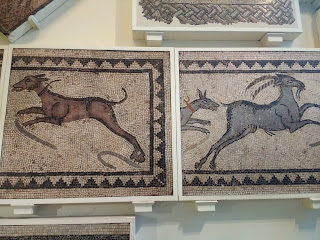Earlier on a fall day last October Steven and I had been enamored with the Egyptian mummies at the world-famous British Museum in London. Having explored one ancient civilization, we were ready to begin to discover another, that of ancient Assyria, now present-day Iraq, as it had been home to other palace-building rulers. People visiting the museum's valuable Assyrian collection are so fortunate to view the priceless artifacts since the recent destruction of ancient sites by ISIS militants has meant there are few to see in situ. Assyria was considered to be the lion or 'king of beasts' in early Middle Eastern civilizations and also called 'the Romans of the East' for their road building and express mail service!
Standing guard over the Assyria gallery was the Colossal Guardian Lion which dated from about 865-860 BC and came from the Temple of Ishtar in Nimrud, Assyria. The fierce 15-ton lion symbolized Ishtar the Assyrian goddess of war and guarded the entrance to her temple.
This remarkable pair of Two-Headed Winged Lions guarded an 11th-8th century BC Assyrian palace and protected the king from evil spirits. It's hard to see from the photo but the scary animal had five legs so it could guard both directions at once. I hope Steven and I will remember to look for a similar pair of winged lions the next time we visit the Metropolitan Museum in New York.
This Eagle-Headed Protective Spirit came from the palace.
If your eyes aren't ready to glaze over already, take a moment to enjoy some of the architecture from the Persian Empire as the museum had more than what now can be seen in Iran. Steven was lucky enough to live in Tehran for two years from 1975-1977 while teaching at an American school and he therefore toured much of that nation. If and when it's safe to travel to Iran someday, we hope to visit the country together.
These stone carvings and glazed bricks were from Persian palaces at Persepolis and other sites in modern Iran. These palaces had large columned halls decorated with scenes carved in stone or glazed brick.
Standing guard over the Assyria gallery was the Colossal Guardian Lion which dated from about 865-860 BC and came from the Temple of Ishtar in Nimrud, Assyria. The fierce 15-ton lion symbolized Ishtar the Assyrian goddess of war and guarded the entrance to her temple.
This remarkable pair of Two-Headed Winged Lions guarded an 11th-8th century BC Assyrian palace and protected the king from evil spirits. It's hard to see from the photo but the scary animal had five legs so it could guard both directions at once. I hope Steven and I will remember to look for a similar pair of winged lions the next time we visit the Metropolitan Museum in New York.
Etched into the stone was cuneiform script, the world's first written language that was invented by southern Iraq's Sumerians over 5,000 years ago and then passed down to the Assyrians.
We then entered a long, narrow gallery lined with stone relief panels that was a miniature version of the throne room and royal apartments of the 9th century BC King Ashurnasirpal II's Northwest Palace at Nimrud. Built atop a 50-acre mound, the palace was 30,000 square feet in size.
In the first panel was the fez-like crown-wearing Ashurnasirpal himself flanked by his supernatural eagle-headed henchmen who were sprinkling incense on him with pine cones. Under his reign, the Assyrians dominated the region from their capital near modern day Mosul.
This Eagle-Headed Protective Spirit came from the palace.
Also in the amazing gallery were battle scene panels which depicted Assyria at war. One, called Attack on an an Enemy Town, showed the king, protected by a shield-bearer, shooting arrows from a safe distance. In front, a wheeled siege-engine, according to the description, and which looked all the world like a modern tank, carried more archers. Inside the 'tank, a lever worked to batter the walls.
In another panel, called Enemy Escape, enemy soldiers were shown attempting to flee Assyrians by swimming across the Euphrates River using inflated animal bladders as life preservers!
The Assyrian king, shaded by a parasol in Review of Prisoners, is seen watching the prisoners parade before him. Above the prisoners' heads are the spoils of war, their booty as the Assyrian economy depended on it. Though the Assyrians had a ruthless reputation for depopulating conquered lands and then moving in their own settlers, their legacy was as builders and not as destroyers.
I hope you still haven't seen too much of the phenomenal Assyrian collection because we were enthralled there was still more to see. We learned in the exhibit called Royal Lion Hunts that lion hunting in Assyria was the sport of kings. As lions lived in the region until the modern era, it was the king's responsibility to keep the lion population down to assist farmers and herders. The duty soon morphed into sport with staged hunts and zoo-bred lions as the kings asserted their power by taking on the king of beasts.
These sculptures were carved about 645-635 BC and showed the sporting exploits of the last great Assyrian king, Ashurbanipal, who reigned for 50 years. The hunt scenes have been described as ranking among the finest achievements in Assyrian art. After the king's men released lions from their cages, horseback riders herded them into arenas where the king cornered them.
In Dying Lioness, I could almost feel the lioness' pain and agony trying to escape after being struck by arrows. I read that Assyria's once great nation was downed just like the brave lions. Soon after Ashurbanipal's death, his homeland was conquered and its capital was sacked and looted by a rising Babylon in 612 BC.
We then headed to the Greek Gallery where the history of ancient Greece spanned from 600 BC-1 AD. When Assyria was controlling the Mideast, the area now known as Greece was only warring tribes and "floundering in darkness." During the Greek Golden Age from just 500-430 BC, its people set the stage for Western civilization to come in terms of democracy, theater, literature, the sciences, art and architecture!
Sixth century Athens produced the finest black-figured vases ever made. The figures were shown in black silhouette against the clay's natural color with details cut through the black surface with a sharp engraving tool. Greeks poured wine from jugs like this one from 540 BC which was painted with a legend from the Trojan War.
Greek pottery had many different uses: at banquets, in religious celebrations, for cooking and storage, and for offerings to the gods and the dead. Athens was the leading producer of decorated pottery in Greece from around 580-300 BC.
In the Kouros or the Torso of an Idealized Youth from 520 BC, we could see how the Greeks viewed their gods in human form and that humans were godlike. They devised a statue type of a youth or kouros as an idealized body, with the ideal man being geometrically perfect. In the statue, that meant finding balance between movement and stillness, and between realistic human anatomy and the perfection of a Greek god.
I know our son-in-law, Will, would love to have seen this Red-Figured Wine Cooler from 490 BC as he's a wine enthusiast and entrepreneur! The half-man, half-animal satyrs were depicted at a symposium or drinking party! Look how far more natural their movements are compared to the kouros above.
Greek temples like this reconstructed Nereid Monument of a temple-shaped tomb from circa 390 BC was the home of a statue or goddess. Greek temples were gods' homes unlike Christian churches which serve as meeting places. As worshippers gathered outside, the exterior was the most important part of the temple.
The triangular space above the columns was called the pediment and was filled with sculptures.
The statues between the columns were friendly sea nymphs or nereids, attired in windblown clothes looking like they might be borne aloft at any moment!
The museum's Parthenon Galleries contained the famous Elgin Marbles named for the early 19th century British ambassador who had his staff remove panels from the temple dedicated to Athena, the goddess of wisdom and the city's patroness. Having been at the Athens' museum, Steven and I clearly understood the Greek government's position that Britain 'stole' some of the Parthenon's and its country's best sculptures. The British still maintain, however, they 'rescued' and 'preserved' them. I was far more inclined to feel the Elgin Marbles should be returned to Greece and that Britain no longer has the right to them if they ever did.
The exquisite marble panels that lined the immense hall were a large part of the frieze that circled the exterior of the Parthenon.
We marveled at the folds of the clothes on the female figures. I read that sculptors first built a nude model of their figure, add real clothes to it, and then studied how the clothes draped before beginning to sculpt in marble.
Look at the centaur grabbing the man by the throat while his hair is being pulled. At the same time, the man is attempting to fend off the centaur with his knee. In the next scene, the centaur is pulling the hair and the man is falling to his knees.
Getting back to where the Elgin Marbles should 'properly' be located, to put things in context the 18th century British considered themselves as the new 'civilized' race and subduing the 'barbarians' in their far-flung empire. However, in my opinion, that period has come and gone and the marbles should also be gone from England.
These stone carvings and glazed bricks were from Persian palaces at Persepolis and other sites in modern Iran. These palaces had large columned halls decorated with scenes carved in stone or glazed brick.
It was hard to realize but Steven and I had only covered the foundations of Western civilization on one floor of just one wing of arguably the world's best museum in a matter of four or five hours our first afternoon in London last fall. It would have taken many more days to fully immerse ourselves in artifacts from other ancient lands. Perhaps some day we'll be able to.
Next post: Walking through the Westminster area of London.
I have also just finished writing a post about a far more recent trip, the one we took just to Sri Lanka and a small part of southern India this past March before we needed to come home because of the pandemic. Here's a link to my post on our train trip from the ancient city of Anuradhapura south toward Gompaha, near the capital:
Posted at long last on June 24th, 2020, from Portland, Oregon as we take a mini road trip to the Northwest on our way home after visiting our darling granddaughter in San Francisco for the first time.


















































































